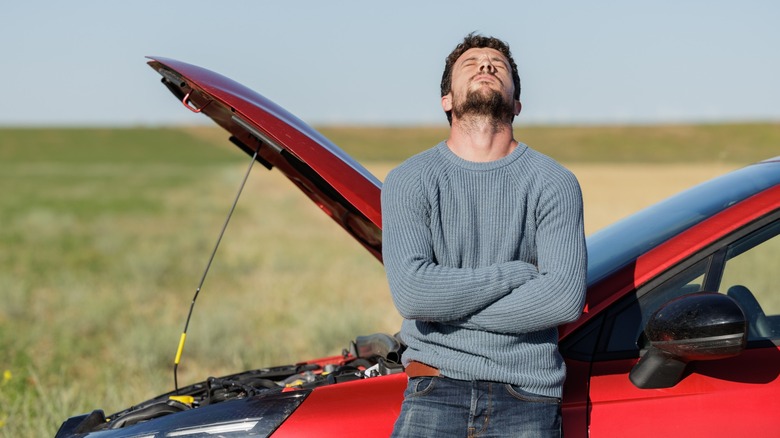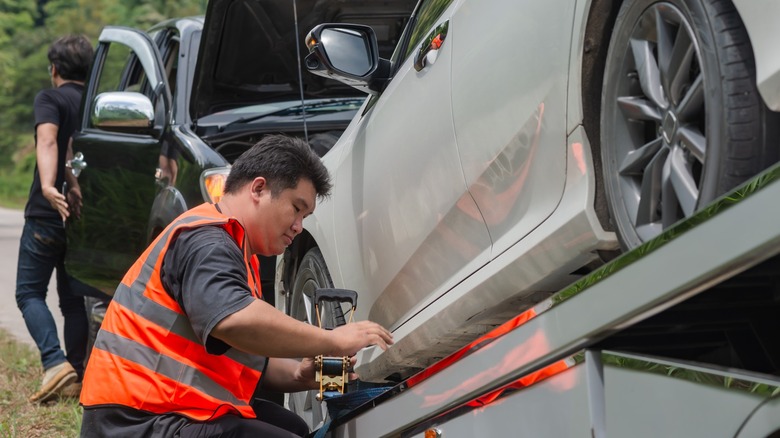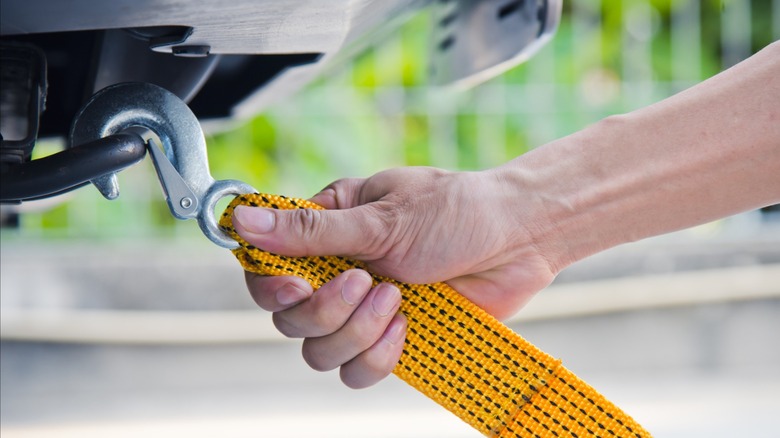These Are The 3 Most Dangerous Mistakes You Can Make When Towing With Your Vehicle
You'd think there's nothing more frustrating than your car suddenly breaking down in the middle of the road. But do you know what's even more annoying? It's helping someone else whose car has broken down, towing it with yours, and then having problems yourself.
Maybe you lean too far into a turn, or a latch slips, and the car you're towing shifts or gets dislodged. At that point, it's not just the car at risk. It's you, the other driver, and everyone else on the road. A small mistake, whether it's the hitch, the speed, or the load, can set off a chain of problems that makes you wish you hadn't offered to help out.
These problems could just as easily occur whether you're hauling a camper for a weekend trip, or towing a boat to the lake. Whatever the reason may be, let's make sure you don't repeat the dangerous mistakes people make when towing with their vehicles. That way, you can avoid a huge, unnecessary dent in your pocket, or car.
Towing with the wrong vehicle
One of the most dangerous mistakes people make is overestimating their vehicle's towing capacity. You can't judge a car's ability to tow just by how heavy it looks. Some small cars are surprisingly capable, while some SUVs are terrible at towing. It's not just about size. A car's towing capacity depends on many things: the type of transmission, the suspension, the brakes, the frame, and even the tires.
Now, you may be wondering if towing can actually damage an automatic transmission car. Well, for starters, towing puts extreme stress on the powertrain. With too much pressure, the engine can overheat, triggering a chain reaction of internal damage from warped heads, piston failure, to total engine seizure. Alternatively, you might start to notice some warning signs your transmission is going bad.
Furthermore, when you're towing, your car's brakes do more work than they were designed for. And depending on the speed, this can lead to overheating. When brake fluid gets too hot, it can cause brake fade.
Tires also carry more weight than usual when towing, and can easily buckle under pressure. A sudden blowout at highway speed can send the car into an uncontrollable skid. Barring any blowouts, the rear end of the tow vehicle may sag, which invariably places a lot of pressure on the shocks, springs, and the frame itself.
So, the first thing you need to confirm is whether your car can really tow another vehicle. That involves calculating the payload and towing capacity and understanding the difference between rated towing and tongue weight capacity. It might seem like a lot of math, but it's crucial to your safety. And speaking of staying safe, if your car is new, don't attempt any towing during the break-in period.
Not securing your tow properly
Don't try to tow a vehicle if you don't have these: a proper hitch, a safety chain, a hitch tightener, and either a backup camera or towing mirrors. This isn't a situation where you improvise. No, it's not safe to use a tow rope or tow strap for anything beyond an emergency. They are designed for pulling a stuck car out of a ditch or dragging a vehicle a few miles to a nearby repair shop. Anything longer, and you're pushing your luck.
When it comes to hitches, there are five hitch classes, each rated for a specific load range. On the light end, you have Class I hitches, which are rated to tow up to 2,000 pounds, with a maximum tongue weight of 200 pounds. At the other extreme, Class V hitches are built for heavy-duty towing. These can handle up to 20,000 pounds with 2,000 pounds of tongue weight. However, they're only suitable for full-sized trucks and vehicles designed to haul that kind of load.
So, choose your hitch appropriately. Never try to force your vehicle or hitch to carry more weight than it's rated for. That's overloading and it can snap the hitch, damage your shocks or bushings, or even cause structural damage to the frame. Another common mistake is hooking everything up without checking how the weight is distributed. Too much weight on one side, or too far back, increases the risk of swaying. Not securing the hitch properly can also cause sway. And once a vehicle starts to sway, it becomes harder to manage, especially in traffic.
To avoid losing control out there, take your time to distribute your load evenly. Lock the hitch latch properly. Use safety chains. And also check that everything is secure before you drive off.
Driving without care
When you're towing, you need to be really precise. So, start by making sure your vehicle is in good condition. Your brakes should be responsive, your tires properly inflated, and your fuel tank full, because towing burns more fuel than usual. You'll also need extra visibility, especially if you're towing something wide or long. Your regular mirrors likely won't be enough, and that's why towing mirrors or a backup camera are essential. There are different types of towing mirrors to expand your rear view. Some clip onto your existing mirrors, while others replace them entirely and can be adjusted to work like a standard mirror, or extended as needed.
Now, don't forget that while towing, your vehicle is pulling extra mass. That means your engine and transmission have to work harder, especially when accelerating. If you try to speed up like you normally would, it'll take longer to gain speed. So, give yourself more time, more space, and don't rush it. If you're backing into a tight space, it helps to have someone else in the car act as a spotter. And if you don't have a partner, that's where a backup camera comes in handy. It's also worth understanding the difference between braked and unbraked towing. Braked towing means the other vehicle's brakes also help you come to a stop. Unbraked towing, on the other hand, relies entirely on the tow vehicle to slow down.
Either way, take your time when changing lanes. Accelerate slowly, brake earlier than usual, and make sure to drive below the speed limit. If you're towing a broken down vehicle, it's a good idea to attach a visible "On Tow" sign at the back, so other drivers get a heads up to keep a safe distance.
How to properly load your tow
As a general rule of thumb, about 60 percent of the weight of the load you're hauling should be in front of the towed axle. This helps reduce the risk of sway. That said, as important as it is to have that much weight forward, you still have to use the appropriate tongue weight. The tongue weight is the portion of the load that rests directly on the hitch ball and transfers to your car. If it's too much, you'll overload your car's rear axles and tires. Too little tongue weight, which is what happens when the load is too far back, just leads to more sway. The trick is to keep the tongue weight between 10 to 15 percent. For that, you'll need a tongue-weight scale.
Now, apart from maintaining the recommended front-to-back loading ratio, make sure you also distribute the weight evenly from side to side. Any imbalance really just increases the odds of the tow tipping while in motion.
Because of how unpredictable it can be, most states have laws in place to make towing safer for everyone on the road. Overall, towing is definitely not something you want to wing. So if you're even a little unsure about your setup or driving skills, consider getting a professional with the right gear and experience to help.




